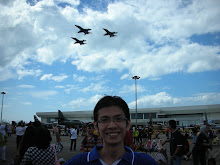 Picture courtesy of Malaysiabest.net
Picture courtesy of Malaysiabest.netUnfortunately everytime want to order, sure have to endure a minimum queue of 7 person and above... and if really even bad luck, those people in the queue will order like 10 take-aways and you have to wait patiently and hoping that the telur bawang won't finish...
After consuming 3 weeks straight of nasi kandar with frequency of at least twice a week, I noticed a consistent pattern from this famous nasi kandar operational standpoint that could be further improved to serve its faithful customer...

As can see from the picture on the left, we could see the setup of the nasi kandar store which consists of 3 workers:
- Worker A and B are dish picker and they manage the customer ordering and attend to the next on the line customer, they only need to gather the rice and know whether customer is dining in or take away. They are capable of doing automated repeat ordering and also some form of telepathic understanding with customers. They also provide costing for each customer
Cycle time: 30 seconds
- Worker C works on packing the order, receive payment of each customer, provide change of the customer, and complete shipping packing bag, he also responsible of providing the utensil if the customer is dining in. This worker C does not have complete control in costing and have to rely on worker A and B for confirmation
Cycle time: 45 seconds to 90 seconds depending on customer payment and amount of orders per customer
The customer also queue up via arrow 1, and then upon completion of order, he / she tracks via arrow 2 and engage worker C for finalization.
So anyone with a bit of common sense would know that having 2 workers working on a short cycle time task while assigning 1 person doing a heavy and highly variable work load is a spell for disaster. Ask anyone that knows Shariff and the first thing they remember is the ridiculously long queue....
If anyone wants to streamline this process, some or all the following shall take place to minimize 'wastage' of customer time:
1) Provide training to worker C so that he had the ability to compute and provide costing of order
2) Allow customer auto payment at counter (means customer put the money and take their change themselves)
3) Reroute the queue line so that worker A and B able to gauge the processing time and provide 'help' to worker C if it holds up (resource management)

4) Relocate either worker A or worker B to do something else other than the front line
One of the plus thing is that every order they manage to use FIFO (First In First Out) system and that is really impressive, the only problem here is storage location for the placed order that could be clumsy, but without fail this system won't go wrong because customer is always there confirming and prevent any wrong order packed.
Maybe despite all that, the secret ingredient is the long wait? They say stuff that you waited long enough would taste better, hehe


No comments:
Post a Comment